Video Release – Assessing Schedule Risk Using Deltek’s Acumen Risk 6.1 | Part 2 of 2
Video Release – Assessing Schedule Risk Using Deltek’s Acumen Risk 6.1 | Part 2 of 2 Read Post »

A recent article discussed the results of a survey on the reasons that projects failed. The definition of failure was that the project was abandoned. Abandonment does not occur frequently in the world of government projects; especially defense projects where there should be strong “must have” needs driving the project. These projects tend to persist until completed even though the outcomes are not satisfactory. But there is a lot to learn from the list of reasons for failure.
Of the sixteen reasons listed, the top four had to do with changes to the environment that had given rise to the project. For example, changes in the company priorities was the most often cited reason for abandonment. In that same vein were issues with changing objectives and inaccurate definition of requirements. These types of failures are not topics for this blog since they do not immediately involve execution of the project.
Lower on the list of those environment related reasons for failure were the ones more related to execution problems. These are of significant interest to a project management using an earned value consulting company such as Humphreys & Associates (H&A). These reasons related more to issues of poor project management that could have been corrected. In this area were reasons like “poor change management,” “inaccurate cost estimates,” “inaccurate time estimates,” and “inexperienced project management.”
The answers given in a survey situation depend very much on the mindset of the person responding. Is the reason really “inaccurate cost estimates” or should it have been “failure to execute to the estimate”? How many times have you seen a problem in execution “swept under the carpet” as being an inaccurate estimate or plan? One of these two answers points to the estimating system and process while the other points to project management. The estimates were generated; and, at some point, they were deemed to be sufficiently detailed to launch the project. If a scrubbed and blessed estimate is “inaccurate” that would still be a failure of project management. If the problem were really a failure to execute, then how easy would it be to blame the problem on poor estimates? This blog will discuss the cited failures as if they were execution failures.
There are situations in life where the need for specialized advice is common and well accepted by us all. When your doctor is unsure of the medical issues, the doctor will send you to a specialist. The reason is obvious. The specialist has learned so much more about a specific problem and has so much experience diagnosing and treating the problem that it would be foolish not to secure the services of that specialist. In fact, it might be malpractice. A project management consultant can be thought of much like a medical specialist.
There are similar situations in business where the need for specialized knowledge is critical. Large companies tend to have in-house legal departments to cover the day-to-day legal issues and tasks that are central to their businesses. However, the need to go to outside counsel for large or unusual issues is accepted. Companies do not hesitate to engage the services of outside law firms to help them through troubled times. Project management consultants are like outside counsel.
What if there were a project management or earned value management situation you have never encountered before? A good example would be the times that H&A has been called in to help clients navigate the unhappy circumstances of needing to go over-target. Going through the over-target-baseline (OTB) or over-target-schedule (OTS) process is not a common experience. It is a tense time when careers can be on the line and the company reputation might also be at risk. It takes specialized knowledge to get it right. In some cases, it even takes the objective view of an outsider to help make the right decisions.
Another example of specialized knowledge being crucial is when the customer has deemed some issue on the project to be deficient. In some situations, a customer’s Corrective Action Request (CAR) can result in cost penalties and damaged reputations; possibly even worse consequences could result. Engaging the services of an EVM consultant with experience in identifying problems, building Corrective Action Plans (CAP)s, and leading or helping implementing the corrective actions is often a valuable and necessary action. Ask yourself how smart it would be to assume that those who were involved in causing the issue would be capable of creating a satisfactory solution.
These scenarios are aligned with the idea of project management consulting being something you only need in a crisis. There are other non-crisis needs for specialized support. Often H&A is engaged simply to help a client prepare a proposal. A proposal situation puts heavy demands on the company staffing levels and can require areas of specialized knowledge not available in the company. What if the company has never created a fully compliant Integrated Master Schedule (IMS) and they could use help the first time? What if there are not enough trained and experienced schedulers to work on the proposal? What if the company does not have a documented project management system?
Projects can be huge and risky. They can be make-or-break opportunities to a company. Where so much can depend on good project management, smart companies recognize the need for an outside opinion and outside talent. Just like the internal legal department, the internal project management group sometimes needs to call on outside subject matter experts. While it might be obvious, let’s look at some reasons why this is true.
There are more ordinary everyday reasons to engage a project management consultant. Perhaps an organization just managed to win a new project bigger than any they have won before. In this case, they may not be ready to handle the project in terms of experience, systems, and even just talented headcount. A project management consulting company such as H&A can bring solutions to your earned value woes. It can also provide temporary training staff to get things going until the client is ready to take over.
Let’s get back to the survey of reasons that projects failed. Are there issues on the list where project management consulting could have made a difference? Imagine an improved project management process and staff after a period of consulting to support creating or improving systems and training personnel?
The fifth most frequent reason for failure is “poor communication.” A good project management system with trained personnel is all about communication. Communication of plans, communication of progress, communication of issues, and communication of corrective actions are all actions required in a project management system. Quite often the problem of “poor change management,” cited as the sixth most common reason for failure, is reduced or eliminated after using the consulting services of a specialist?
What about the twelfth cited problem of “inadequate resource forecasting”? Would a well built and maintained resource-loaded Integrated Master Schedule (IMS) go a long way in providing forecasts of resource needs and the impacts of not having the resources? In fact, a proper IMS would help with several of the cited reasons for failure, such as inaccurate duration estimates. In fact, the application of a process, such as Schedule Risk Analysis (SRA), with the help of an experienced consultant can identify such issues in advance while there is still time to take action.
Disregarding the threat of failure as a motivator, the need for constant improvement should be enough reason to consider a project management consultant. We can all laugh at the time-worn clichés of “not-invented-here” or “we’ve never done it that way;” however, these are clichés for a reason. There is resistance to outside help and there is resistance to change. But outside help can be a great logjam breaker. An experienced and knowledgeable consultant can be your voice when you need someone who has, to use another cliché, “been there and done that.”
In fact, our consultants can laugh when they say they have “been there” and they have more than a T-shirt to prove it.
Project Management: Earned Value Consulting; Could You Use Some? Read Post »
 Recently one of our consultants was instructing a session on the Integrated Master Schedule (IMS) with a group of project personnel from one of our larger clients. The group was a mixture of beginners with no real experience in schedules and some much more experienced practitioners; some with more than 10 years of experience. The mixture made it somewhat difficult, but it also made for some interesting discussions that might have been missed in a more homogenous group. One of those things was the usefulness or importance of the “time-now” line.
Recently one of our consultants was instructing a session on the Integrated Master Schedule (IMS) with a group of project personnel from one of our larger clients. The group was a mixture of beginners with no real experience in schedules and some much more experienced practitioners; some with more than 10 years of experience. The mixture made it somewhat difficult, but it also made for some interesting discussions that might have been missed in a more homogenous group. One of those things was the usefulness or importance of the “time-now” line.
When the group was asked about the importance of the time-now line and what information could be easily gained from a look at the line, there was silence. The beginners did not have a clue but also none of the experienced people had any response. What should have been a short discussion with just one “slide” as a visual, turned out to be a longer and more informative session on this topic.
The time-now line has different names in different software tools but it refers to the data date, or status date, of the schedule. That also would be the first day of the remainder of the schedule. When a scheduler sorts tasks by date, the time-now line runs down the screen and forms a highly useful visible reference.
In the small example below [see Figure 1], you can see the time-now line and visually assess the situation. Time-now is shown by a vertical line at the beginning of September, so all remaining effort has been scheduled to after that date. In other words, no work can be forecasted in the past. A walk down the line shows Task 1 has both started and completed. Task 2 started but has not completed. In fact, the remaining work in Task 2 has been pushed out by the time-now line. The start of Tasks 5 and 9 are also being pushed out by the time-now line. In most real project schedules, filters and other techniques may be needed to isolate information like this; but in our small example, we can simply “eyeball” the time-now line and see valuable information. Task 9 starts the critical path shown in red tasks.
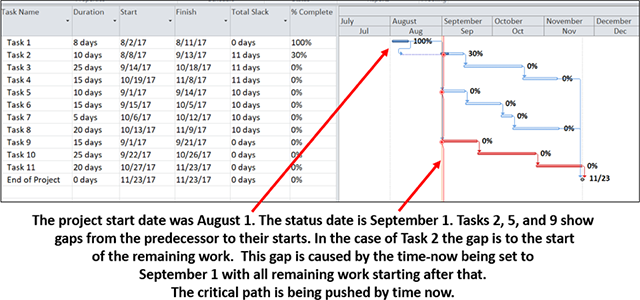 Figure 1
Figure 1
A slightly different setup for that same small example [see Figure 2] shows something interesting. The time-now line is still at the beginning of September. But now there is a gap between time-now and work on the critical path. This is an unusual situation and should be investigated for the root cause. It is possible this is an accurate portrayal of the situation, but regardless of the cause, it must be verified and explained.
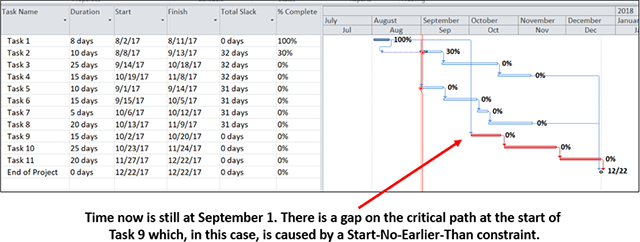 Figure 2
Figure 2
In yet one more variation [see Figure 3], we see that a broken link results in Task 8 ending up on the time-now line. A task without a predecessor will be rescheduled to start at the earliest possible time (if the task is set to be “As Soon As Possible”). And the earliest possible time is the time-now line; the beginning of September. Just as broken things fall to the floor in real life, “broken things” fall to the time-now line in a schedule. Un-started work can land there. Un-finished work can land there. And un-linked work can land there.
It is further possible to see that Task 2 has had an increase in the remaining duration that has driven it onto the critical path. Task 2 at this moment is the most important task on the entire project. A slip to Task 2 will drive out the end date for the entire project. One question that needs answering is what is holding up Task 2?
If the display had been sorted by increasing total float/slack and the usual cascade by date, then the critical path would be starting at the upper left-hand corner; like the critical path in this example. The action on the project is almost always on the time-now line and the most important action, when sorted as described, will be at the upper left-hand corner.
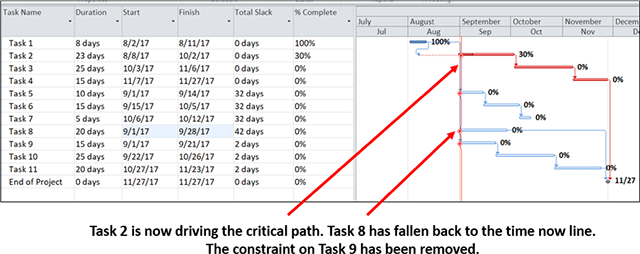 Figure 3
Figure 3
So, a walk down the time-now line can help us see the critical path action, find broken parts of the schedule, and locate unusual circumstances that need our attention. Our recommendation is to look at the time-now line any time there is data being changed in the IMS. This will help you catch issues early and keep the schedule cleaner.
Along the IMS Time-Now Line Read Post »
The first, and higher level output, is the Risk Exposure Chart. This chart depicts the level of confidence that the project scope, as modeled in the IMS, can be completed by a certain date. The chart commonly includes a histogram depicting the number of project simulations that are being completed on each specific date, and a curve that shows the cumulative values across time up to a 100% confidence level. Using the Deltek Acumen Risk Exposure histogram, the baseline finish, forecasted finish or any other desired date can be examined, as well as determination of the probability of achieving that date based on the number of simulations completing on or before that point in time.
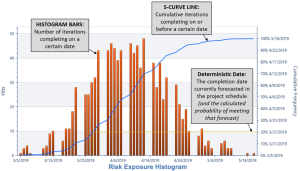
Now that you know there are problems, what are you going to do about them? On which tasks should mitigation attempts be made? Is the current critical path comprised of the riskiest tasks? This is where the second area of intelligence output comes into play.
Acumen produces a list of “risk drivers” in the form of a Tornado Chart. These are the tasks that are expected to have the greatest influence on risk in the schedule. Put another way, this report highlights the tasks that, if they could be executed in less time, would have the greatest impact on increasing the likelihood of an on-time project completion. Acumen’s rendition of the Tornado Chart also displays the amount of the risk that can be attributed to duration uncertainty, logic, or any of the risk events. New to Acumen 6.1 is the ability to easily display this information in either days or hours.
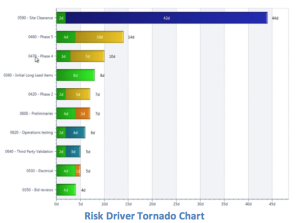
But how does one know if all of the time and effort that has been spent mitigating risk is working? Acumen can help here too. The initial (unmitigated) plan can be compared to the current (mitigated) plan. Has risk been reduced as expected? Or, because of mitigation efforts in one area, has risk increased in other areas (a.k.a. collateral damage)? Stacking the results within the Tornado Chart, it can quickly be seen which risk drivers improved, were unaffected, or deteriorated.
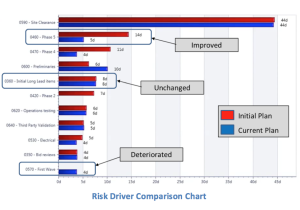
The goal of any SRA tool is to identify and quantify schedule risk to a project so that action can be taken to improve project execution. Used properly, Acumen Risk does exactly that. With over 20 years as a full-time scheduler, I have dealt with thousands of project schedules and many, many analysis tools. From what I have seen so far, Acumen is an evolutionary step in performing schedule risk assessments. It offers beginners an easy path to perform in-depth schedule analysis with advanced features for more experienced users to help further refine the accuracy of the results. I encourage you to register for a free trial version and test it out for yourself.
Yancy Qualls, PSP
Engagement Director, Schedule Subject Matter Expert
Humphreys & Associates, Inc.
Assessing Schedule Risk Using Deltek’s Acumen Risk 6.1 | Part 2 of 2 Read Post »